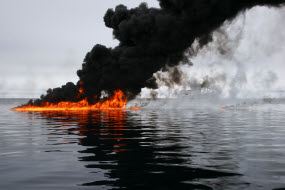
|
| Burning the oil in situ can be very effective, and in certain cases it may be the only way of keeping it under control.Photo: SINTEF |
They included a series of tests of oil skimmers and fire-resistant oil-booms, the burning of floating oil and a monitoring experiment that was controlled via satellite.
The tests produced promising results that offer a basis for the further development of measures to protect against oil-spills in ice-infested regions.
World’s biggest oil-spill contingency programme
The experiments were carried out as part of a major international collaborative research programme, “The joint industry programme on oil-spill contingency for Arctic and ice-covered waters”, which was launched in 2006.
This is the world’s largest and most wide-ranging R & D programme on oil-spills to date, with a total budget of NOK 60 million spread over three and a half years.
Six oil companies, SINTEF and several other organisations are collaborating in the programme, which aims to upgrade our knowledge, technology and ability to react rapidly in the event of a disaster. For companies such as StatoilHydro, Agip KCO, Total, Conoco Philips, Chevron and Shell, this is important, as they all operate under Arctic conditions.
Important knowledge
The project includes projects at three levels: laboratory trials at SINTEF SeaLab, field experiments in Svea on Svalbard and offshore field experiments in the marginal ice-edge around the Svalbard archipelago. Field experiments are extremely important as a means of verifying the findings of laboratory studies under realistic conditions.
The projects are looking at how oil behaves under a wide range of ice conditions, and are trialling various methods of collecting and dealing with oil, in order to improve the efficiency of oil-spill contingency measures in these regions. Burning the oil in situ can be very effective, and in certain cases it may be the only way of keeping it under control.
